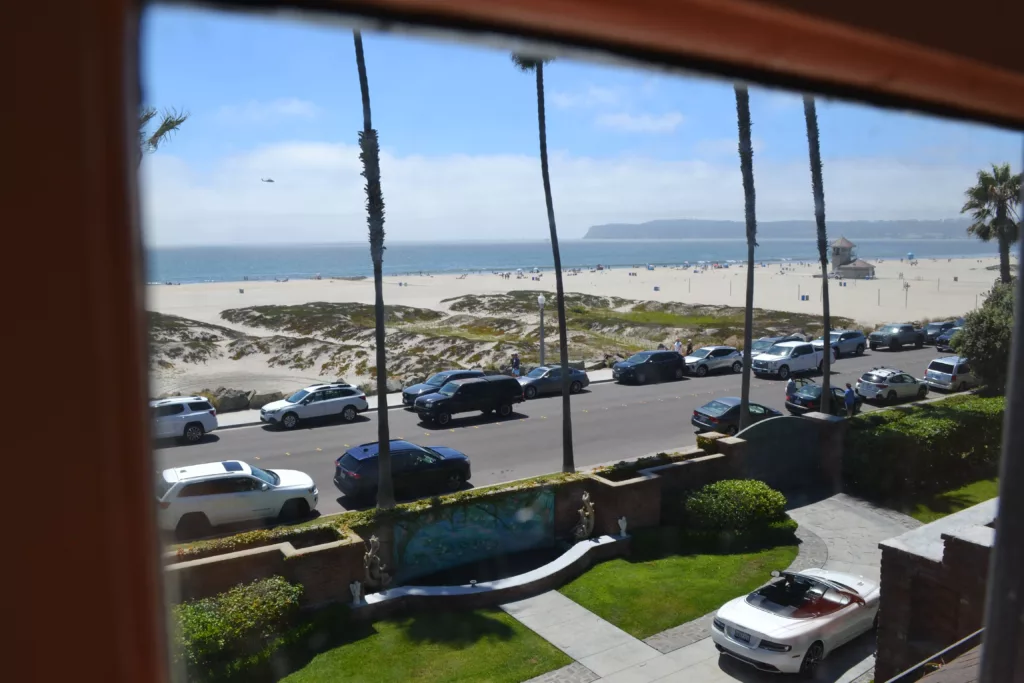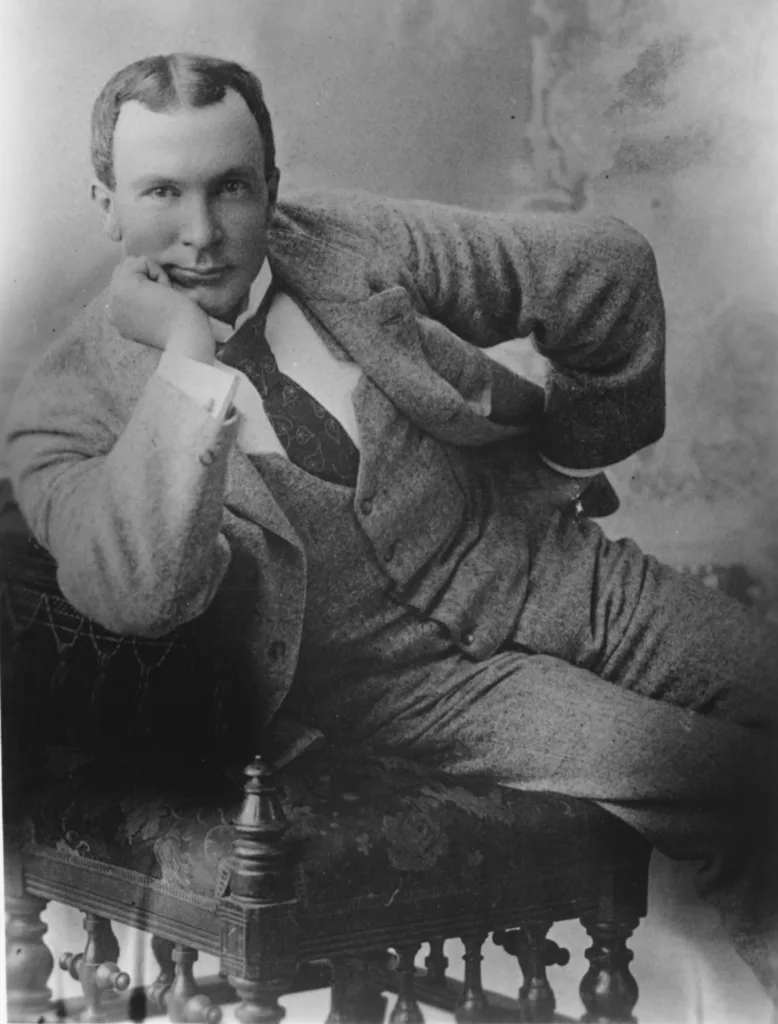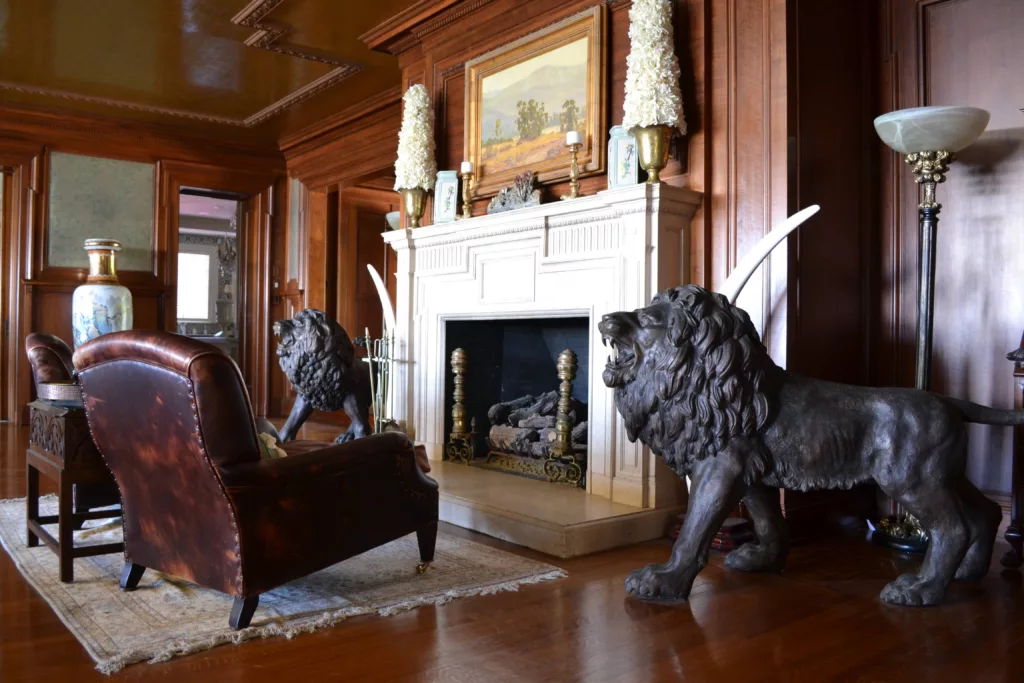CORONADO, Calif. – The tides were hungry in the winter of 1905, the waves relentless, and Bartlett Richards’ new mansion – his wife called it “Tranquillo” – teetered on the edge.
The wide, dirt boulevard that once separated his tidy front yard from the beach now crumbled into the Pacific. Neighboring homes stood on jacks, awaiting a horse-drawn retreat, and sweaty men in salty boots stacked 200-pound sandbags like hay bales in the surf. Seven thousand down. Twenty thousand stuffed and ready. The highest tide, newspapers reported, still to come.
For the most notorious cattle king in Nebraska history, founder of the iconic Spade Ranch and president of the Nebraska Land and Feeding Company, his family’s winter retreat wasn’t likely his main concern.
Just two years before, a federal grand jury had indicted the Spade for illegally fencing more than 200,000 acres of government land. His lobbying campaign to maintain said fences had withered in Washington. And he and his partner Will Comstock were now awaiting trial in the U.S. District Court in Omaha. All the while, a new wave of immigration – spurred by the Kinkaid Act and its promise of free land – was laying claim to what Richards and other Sandhills stockmen had long considered open range.
Richards’ empire, like Ocean Boulevard itself, was crumbling fast. And yet here he was, 1,600 miles from the ranch, fighting the tide all over again – literally.
He served with a committee representing property owners along the boulevard. He advocated for a sea wall constructed by the city of Coronado. And he offered $1,000 toward any such undertaking, which the city completed the following year by passing a bond and laying roughly 67,000 tons of granite by rail and crane.
As a result, Tranquillo still looms large today – twice as large, in fact. The mansion almost doubled in square footage. The boulevard was paved. New owners moved in. Old owners moved out. Celebrities wined, and lawmakers dined, and now this forgotten slice of Nebraska history — what many Coronadans consider the island’s most iconic estate — could be yours for a cool $40 million.
“Go tell Warren [Buffett] about it,” said broker Scott Aurich in August, standing in the horseshoe drive between two stone lions and his blinding white convertible, an Aston Martin DB9 GT Volante. “Tell him Bartlett Richards lived here.”
***
More commonly known today as “Crown Manor,” Richards’ second home stood one block north of the famous Hotel del Coronado, where he often sojourned after marrying his niece, Inez, in 1897.
They stayed for weeks, sometimes months at a time, usually when his beloved Sandhills were covered in snow, hobnobbing with the Coronado elite. Sometimes they were accompanied by Richards’ brother-turned-father-in-law DeForest Richards, then governor of Wyoming.
Eventually, they established roots. In March 1901, they bought four lots on Block 13, less than 500 yards from The Del and a stone’s throw from the Pacific, with an unobstructed view of the Point Loma peninsula spooning around the bay.
According to local historian Ray Brandes, who compiled the property’s historic resource application for the city in 1984, the same land had changed hands roughly 30 times over the previous decade alone. Some for speculation. Others, he wrote, “stimulated by the prospect of a vacation spot,” only to back out when “more reality set into their lives.”

The Richardses, no doubt, were stimulated by the same, but unlike their predecessors, the reality back home only reinforced their investment.
Despite drought and depression, the 1890s were a decade of sweeping development on the Spade, an operation now spanning nearly 800 square miles in Sheridan and Cherry counties. By the turn of the century, newspapers nationwide often referred to Richards not merely as a rancher, but a “wealthy cattleman.”
Come October, a massive pile of bricks appeared on Block 13. By November, specs had been submitted to the county recorder for “a very handsome house,” according to the San Diego Union newspaper.
Designed by Frederick L. Roehrig, nicknamed the “Millionaire’s Architect,” plans for the home “were laid down in an evident spirit of hospitality,” the Union reported, “as there were something like twenty guest rooms and fourteen maids’ rooms with other features in proportion.” (Many today credit the design to architects Irving J. Gill and William S. Hebbard. But the Coronado Historical Association notes the original plans no longer exist, and no contemporary documentation has been found directly linking the mansion to the partners’ firm.)
Historically, any residence greater than 5,000 square feet was considered a mansion. Tranquillo, from its very inception, was roughly 15,000 square feet, not counting the larger estate on which it stood, abloom with agave and shade trees, nor the mirage of eternity – the shimmering Pacific – crashing ashore just outside the screened and double-hung windows.

Completed for roughly $25,000, the Tudor Revival stood three stories tall and included, beyond the aforementioned guest rooms: a formal living room gilded with gold leaf and encased in old mahogany, a full basement, a dining room tailored for 20, a kitchen, a butler’s kitchen, a map room, seven and a half bathrooms, three mammoth fireplaces, steam heating, two elevators, and a red shingled roof to clothe the timbered gables.
“One of the most attractive homes on the beach is that of the Bartlett Richards’ on the Ocean Boulevard,” reported the Union in December of 1902. “The interior fittings are very elaborate, and the furnishings are splendid throughout the house.”
Over the next decade, Richards continued to migrate between the ranch back home, his business interests elsewhere, and his very own Xanadu in the so-called “Crown City” of California.
Though he’d built a stunning home at the Spade Ranch headquarters in tiny Ellsworth, Nebraska, the rest of his family spent more and more time in Coronado. By 1903, even Richards’ mother, Harriett Bartlett Jarvis Richards, had comfortably settled in.
They hosted garden parties and fundraisers and a musical for Harriett’s birthday – costumes and old Irish ballads – and a wedding reception for Spade partner Will Comstock, too. They built a garage for Richards’ new cars when the word “garage” still required quotation marks. They welcomed their fourth child, Elise. And in 1905, they fought the sea; or rather, they watched The Del’s growing army fight the sea, desperate to save the hotel and the resort town it birthed, the pier – like the boulevard – already swept away.

Inez named the mansion “Tranquillo,” a musical directive used to indicate a calm or relaxing manner. Whether her husband ever obeyed the directive, given the chaos back home, is another matter.
A jury soon found Richards and Comstock guilty of violating the Van Wyck Law of 1885, which prohibited fencing of the public domain. A year later, after an exhaustive 24-day trial, they were convicted of both land fraud and conspiracy to commit perjury, too.
Like other Sandhills ranchers, they had paid Civil War widows, the elderly and other so-called “dummy entrymen” to file homestead claims and turn them over to the Spade. They were fined $1,500 each and sentenced to one year in prison.
They appealed for years, but finally, in 1910, he landed behind bars at the Adams County jail in Hastings, a world apart from the opulence of his winter quarters.
Convinced of his innocence, he refused visitors to the very end. Not his children. Not even Inez. He wrote to them at Tranquillo, instead, planning future vacations while ignoring the reality of his failing intestines.
With just weeks to go on his sentence, Bartlett Richards died. Doctors called it “ileitis,” or inflammation of the small intestine. Others called it shame.
“So keenly did Mr. Richards feel the sting of the trial, conviction and the wearing of the convict’s garb that it is said he became a changed man at once,” wrote the Los Angeles Herald. “And with the progression of time that humiliation increased until it ate its way into the innermost recess of his heart and caused it to break.”
***
During his earliest years in Coronado, when he was still lodging at The Del, Richards sometimes golfed with a fellow guest named Walter Dupee, a skilled horseman and the son of a wealthy Chicago stockbroker.
How close they remained in later years is uncertain, but shortly after Richards’ death, Inez sold Tranquillo to Dupee, who had since established himself as the country’s preeminent polo player. Today, he’s widely credited with popularizing the sport in North America.
“So, when Bartlett Richards owned the house, it stopped right here,” Aurich said, pointing toward a faint discoloration in the brick. Everything beyond it was the Dupee addition. “He used this whole place to house polo players.”
In 1914, Dupee and his wife Florence contracted with Roehrig, the original architect, to expand the home by an extra 10,000 square feet, creating two additional wings for another $22,000. When the construction crews finally cleared out, the mansion boasted 40 rooms.
To keep them clean, reports claimed, they hired 10 servants. To furnish them, they hired the country’s most renowned interior designer, Elsie de Wolfe, now considered the inventor of the entire profession.
Soon the Dupees divorced. Florence remarried U.S. Congressman George Burnham. They hosted parties and fundraisers, navy admirals and bigwigs from The Del and President Taft’s brother and sister. After the congressman died, Florence tried converting the lots into a Christian Science resort. The zoning commission said no.
Florence sold the estate to a man, who sold it to another man, who sold it to some other men, who sold it, in 1978, to Dr. Morton and Carol Pastor, who put their seven daughters to work stripping away decades of ivy and old carpet and cleaning up the mess the previous owners had left behind.
“It was in absolute shambles,” Carol said recently, picking apart her scone at Tartine, a small cafe on the opposite side of the island. “This group of guys would throw their keg parties in the dining room. And because the plumbing wasn’t working – there was only one bathroom that worked out of 13 – they would open a window and urinate into the bushes.”
They refinished the floors and remodeled the kitchen. They hired plumbers and electricians. They added a swimming pool. A diving board. A waterfall. They hosted the mayor of Los Angeles and the governor of California and a black-tie fundraiser for the theater arts department at San Diego State, attended by director Ron Howard and “The Fonz” himself, Henry Winkler.
In 1979, what they now called the “Richards-Dupee Mansion” was chosen by the San Diego chapter of the American Society of Interior Designers for its annual showcase, ushering thousands into their home.
“It was open season,” Carol said.
They spent six happy years in the mansion before the owner of The Del, now a National Historic Landmark, came knocking. His name was Larry Lawrence. He was a major donor to the national Democratic Party. He was one of the richest men in America. And he was envious, Carol claimed, of all the publicity they’d received for the restoration.

Whatever the case, he proposed a trade: the Richards-Dupee mansion for one of the many other homes in his nationwide portfolio. The Pastors settled on his property at the local golf course, admitting amongst themselves the mansion had grown “ridiculous” with only two daughters left at home.
Lawrence rechristened his new mansion “Crown Manor,” hoping to make it a satellite of The Del, “where executives would stay and pay big bucks,” Carol said. The city planning commission swiftly rejected his request, just as it had Florence Dupee’s so many decades before.
But he held onto it regardless, ripped out the pool, put another one in, made extravagant renovations, and finally, after he was appointed U.S. ambassador to Switzerland in 1994, opened the home to President Bill Clinton, triggering rumors of an extramarital affair between the president and Lawrence’s fourth wife, Shelia. Under deposition, both parties denied the accusation.
Lawrence died in 1996. His family sold it. For more than 20 years now, Crown Manor has been owned by Christopher J. Bower, founder and CEO of Pacific Corporate Group, a private equity firm. In 2020, after living in the home for roughly 20 years, Bower submitted a joint request with Hilton Hotels – which now owns The Del – to repurpose the property for special events.
“I have taken great pride to maintain a historically accurate property inside and outside, to preserve the legacy of Crown Manor for the community, but I can’t continue to do so,” he told the commission via Zoom. “If I can’t make Crown Manor economically viable, I would have to sell it.”

The commission, once again, denied the request, flooded by what the vice chairman called “a tidal wave” of negative feedback. Shortly after, Bower re-listed Crown Manor for $34 million. Then $36 million. And as of May 2022, $40 million. It’s been on and off the market ever since.
Carol scoffed at its trajectory, calling it “overpriced up the wazoo,” but for Aurich, and presumably Bower – who couldn’t be reached for comment – it’s hardly out of line.
“Look at it this way: Most of the houses in this market have gone up more than three times what they could have sold for in 2003. He bought this 20 years ago for $15 million,” Aurich said. “Or you can look at it this way: the average square foot price of these houses on Ocean Boulevard is over $2,000 per square foot. And this is 24,000 square feet. That’s $48 million.”
The issue is less the asking price, he argues, than the mansion’s “functional obsolescence.” Hence Bower’s request for a zoning exception, and Aurich’s preference – currently shelved – to split Crown Manor into eight condominiums. Since 2002, the mansion has been protected from demolition under the Mills Act, which provides owners of historic homes a tax break in exchange for preservation and restoration of the property.
“But there’s probably a way it could happen,” Aurich said. “The irony is that if this house was torn down, the land’s worth $40 million. So I worry that at some point in time, it’s just going to be so functionally obsolete that someone goes that route …”

In recent weeks, Bower removed Aurich from the assignment and again delisted the home. According to Seth Nelson of The Eklund/Gomes Team at Douglas Elliman Real Estate, Bower’s new brokerage in New York City, “$40 million is the current asking price … It is an exclusive off market opportunity at the moment, but will likely resurface to the open market by year’s end – if we haven’t sold.”
***
Nearly a decade after the sea wall was completed, the city of Coronado redirected Richards’ $1,000 donation toward the purchase and installation of the first ornamental electric lights along Ocean Boulevard.
“The poles are to be placed along the curb of the walk next to the seawall, and will make a beautiful promenade, and one that will show up in great shape to passengers of ships making the first port of call,” reported the Coronado Strand in 1914.
It was a project, Inez claimed, “directly in line” with her late husband’s interests, and one he would have heartily approved for “the place he loved to rest in.” A bronze plaque was later placed along the boulevard in Richards’ honor, though what became of it, said Vickie Stone, curator of collections at the Coronado Historical Association, is unknown.
“Pure speculation on my part, but there were several bad winter storms in the 1920s that may have damaged it or required it to be removed.”
And so perhaps the tides won out after all, his memory swept clean from Coronado, his slice of paradise for sale, his peace of mind “an exclusive off market opportunity” for anyone with $40 million to spare.
The Flatwater Free Press is Nebraska’s first independent, nonprofit newsroom focused on investigations and feature stories that matter.




22 Comments
As a former San Diego resident, and frequent Coronado visitor, I really appreciated your story. I was unaware of the Nebraska connection to that home.
“Dang” I just love off the beaten path stories like this. You must have spent a ton of time researching this history.
I’m 2 full years into retirement now, but I seem to work harder and have less free time than my working years. I give freely of my time helping others, mostly neighbors and sadly helping widows with projects their husbands likely used to do. But I have beautiful equipment and a fair amount of experience in most things related to home and farm projects.
5 year ago I had Multifolcal lenses implanted in my eyes after developing cataracts in both eyes. Now I rejoice because the high tech lenses mean I no longer need reading glasses and will never need corrective lenses ever again. I laugh when walking in the rain, after a lifetime of wiping glasses dry, something I never have to do.
And reading is my escape. It takes me places I will never go in my lifetime. Thanks for being one of my favorite authors.
Wow! Great article!
Thank you for this very interesting article. I continue to be amazed at the history of Nebraska, and your attention to detail to bring the past back to life.
Very interesting article of Nebraska history and current history. I have been to Ellsworth, Nebraska and saw the State Historical marker about the Spade Ranch. I didn’t know anything about it. Our families came to eastern Nebraska to settle on the late 1800’s.
I meant to say my family settled in Nebraska in the late 1800’s.
My wife’s grandfather was a cowboy for the Spade Ranch. Have a picture of the cowhands standing in front of the bunkhouse. Lived about 15 miles north of Ellsworth, NE and her family stills owns that ranch. As we understand, Ellsworth was the ‘summer headquarters’ for the Spade Ranch.
Great stuff as usual Carson. All new information for me. Thanks.
Bartlett Richard’s was one of the original founders of Stockmens Bank, in Rushville, Nebraska now Security First Bank and celebrating our 125 anniversary!
As always, Carson works the English language deftly to weave amazing stories. Not a hint of balderdash in the entire piece.
Cattle Ranchers are real in Nebraska.
I appreciate a good historical story, but the story went off the rails for me when it mentioned he married his niece. So not only is he his children’s father, he is also their great uncle?!
Great article, went to San Diego in 1965 as a navy recruit, was then stationed n the area for 3 years and as a small town boy from Nebraska I was fascinated by the Hotel Del and was hoping to stay their sometime but haven’t done it yet, they started the bridge while I was their also.
Very interesting story about this house but…. I want to know more about the Game of Thrones/Yellowstone twists with Richards marrying his niece (why was that allowed!!!!), whose father was the governor of Wyoming, and doing anything to keep his land!
I’ve lived in Coronado since 1955 and we always referred to it as the Vanness Estate.
I was amazed at the background I knew nothing about! We were so surprised when a former Seal, Greg McPartlin, was able to buy several acres surrounding the property and adding more homes, at a huge profit! I’m surprised this wasn’t included in the
article. My husband and I did attend the Designers Showcase in 1979, and although the entire house wasn’t on display, we saw enough to appreciate its history and it’s beauty.
I am a Coronado native in my mid 70’s. I agree with you Joan with one correction. Greg McPartlin became a realtor after the Navy. He purchased the Vaness (?) mansion which extended from Ocean Blvd to Star Park. He split off the back part of the property and developed it as opposed to buying additional acreage. Unfortunately some of Coronado’s history in current magazines or other media is inaccurate or left out by those who were not around to witness it. I have great regard for Scott, the Coronado Historical Society and others but arriving in the 70’s or 80’s does not always lend itself to writing about events before your time.
Most confusing article I have ever read. This guy bounced between Coronado and Nebraska so often I thought it was a tennis match.
Thank you so much for this extremely fascinating and inspiring story of a family and there history. When a family loses there Chief things tend to go sour fast I know this all to well. Great writing.
Carson Vaughan, I am now a huge fan. I liked the zoo book, but this article–WOW. Your writing is amazing. Wow, wow, wow!
Great article! Around 1985 a family by the name of Morgan was using a former Spade Ranch building in Ellsworth for sewing high quality canvas goods. . I still use the saddlebags I bought from Morgan’s forty odd years ago.
I am from Ellsworth. My Great-Grandfather was Lawrence Bixby. Morgan’s (the old Spade store) is still open and doing well.
However, they no longer do the bags. I continue to treasure the ones I have 👍🏻
I ride my bike by “Crown Manor” most evenings. I had no idea of the early history (pre-Dr Pastor-and family). You did a wonderful job of relating this fascinating story. Thank you!